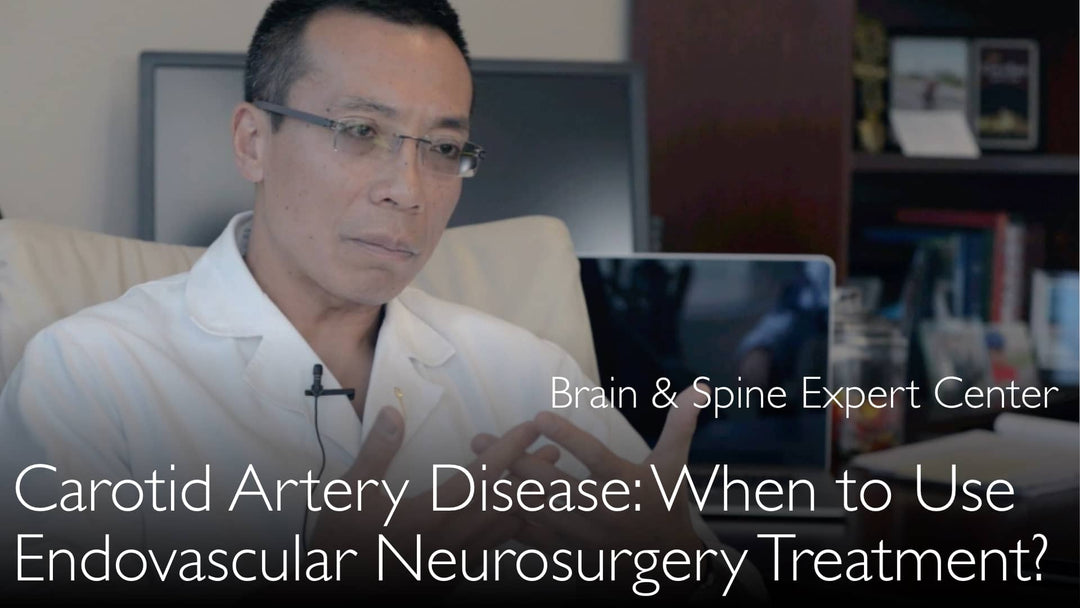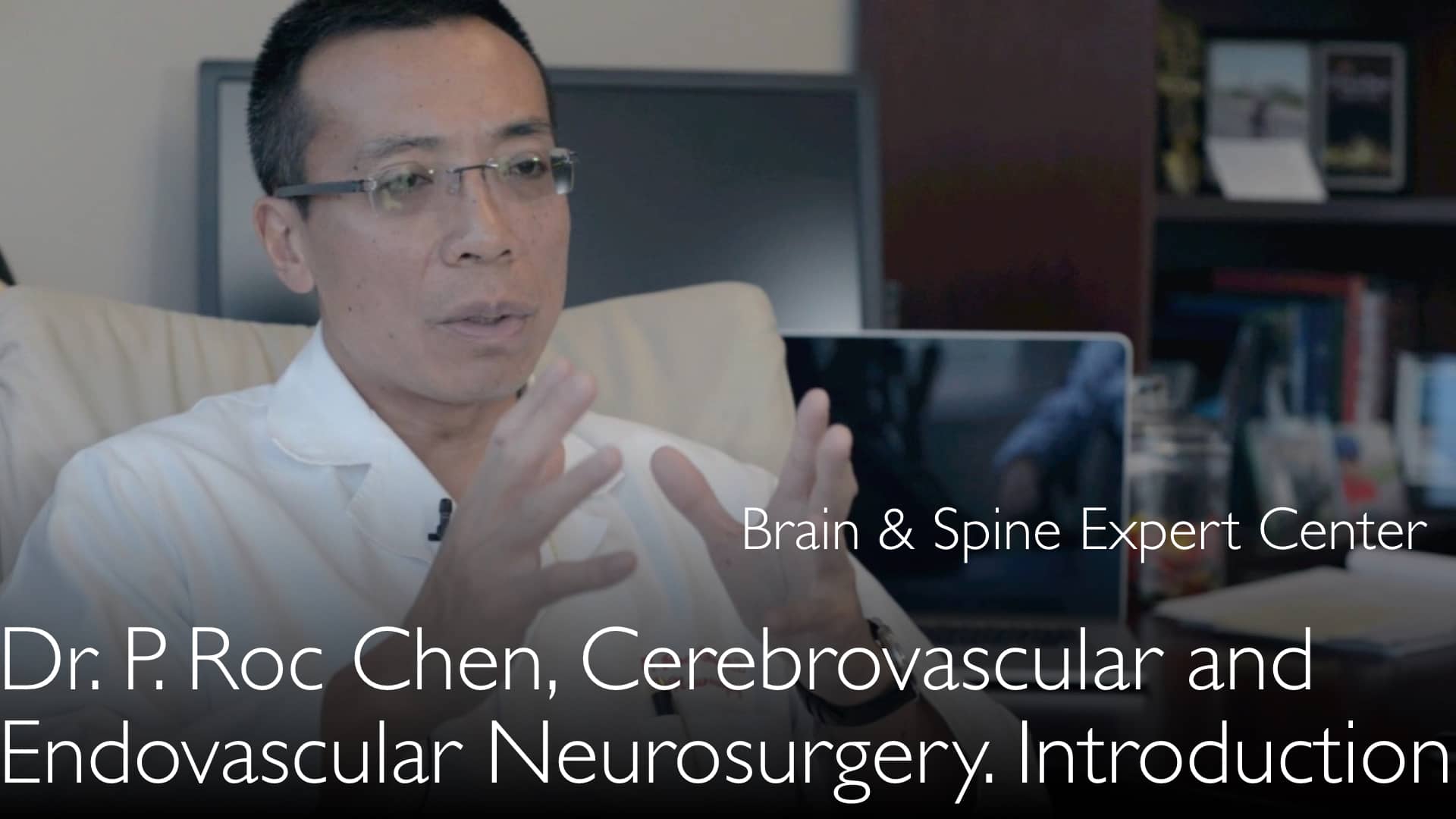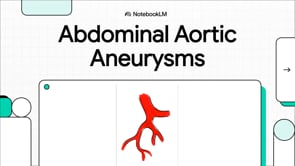Dr. Peng Chen, MD, en ledande expert på kärlkramp i halspulsådern och neurokirurgi, förklarar hur aterosklerotisk plack orsakar stroke genom att inskränka blodflödet eller skicka emboliska fragment till hjärnan. Han går igenom de välbeprövade fördelarna med karotisk endarterektomi och den allt viktigare rollen för endovaskulär stentning, samt belyser specifika patientfaktorer som avgör den optimala behandlingsmetoden för långsiktig minskning av strokerisk.
Behandling av karotisartärsjukdom: Kirurgiska och endovaskulära alternativ
Hoppa till avsnitt
- Vad är karotisartärsjukdom?
- Kirurgi för karotisendarterektomi
- Stentbehandling av karotisartären
- Val mellan kirurgi och stent
- Högriskpatienter för stentbehandling
- Behandling av tandemläsioner
- Individuell patientbedömning
- Fullständig transkription
Vad är karotisartärsjukdom?
Karotisartärsjukdom innebär ackumulering av aterosklerotisk plack, oftast vid karotisartärens delningspunkt i halsen. Enligt Dr. Peng Chen, MD, begränsar detta plack blodtillförseln till hjärnan och medför en allvarlig risk: fragment kan lossna, färdas till hjärnans mindre kärl och orsaka en ischemisk stroke.
Kirurgi för karotisendarterektomi
Karotisendarterektomi är en väletablerad öppen kirurgisk metod för att avlägsna plack från karotisartären. Dr. Peng Chen, MD, framhåller att kirurgi rekommenderas för patienter med en förträngning (stenos) på över 70 %, oavsett om de är symptomfria eller inte. För patienter som nyligen drabbats av stroke eller TIA (transitorisk ischemisk attack) är gränsen lägre, vid 60 % stenos. Banbrytande studier från 1990-talet visade att ingreppet minskar tvåårsrisken för stroke med cirka 26 % jämfört med enbart medicinsk behandling.
Stentbehandling av karotisartären
Endovaskulära tekniker som ballongangioplasti och stentering erbjuder ett minimalinvasivt alternativ för behandling av karotisstenos. Dr. Peng Chen, MD, noterar att långtidsresultat från kliniska studier visar att återfallsrisken och den övergripande effektiviteten för stentering är mycket lika den för öppen kirurgi, med cirka 5 % långtidsrisk för återförträngning för båda metoderna.
Val mellan kirurgi och stent
En central fråga inom behandlingen av karotisartärsjukdom är att välja rätt patient för rätt metod. Dr. Peng Chen, MD, betonar att en generell riktlinje är att överväga endovaskulär stentering för patienter med hög risk för öppen kirurgi. Beslutet kräver en noggrann, individuell bedömning och är inte en standardlösning.
Högriskpatienter för stentbehandling
Dr. Peng Chen, MD, beskriver specifika patientgrupper där karotisstentering är särskilt fördelaktigt. Detta inkluderar patienter med återkommande stenos på samma sida efter tidigare endarterektomi, de som fått strålbehandling i halsen mot cancer, och personer med nervskador eller stämbandsdysfunktion från tidigare kirurgi. Patienter med nedsatt hjärtfunktion eller extrem övervikt som kan ha svårt att tolerera narkos är också lämpliga kandidater för den endovaskulära metoden.
Behandling av tandemläsioner
Endovaskulär stentering har en unik fördel för patienter med tandemläsioner, där det finns en förträngning både i halsen (extrakraniell) och inuti skallen (intrakraniell). Som Dr. Peng Chen, MD, förklarar, kan öppen kirurgi endast åtgärda läsionen i halsen. Med en endovaskulär procedur kan däremot båda förträngningarna ofta behandlas samtidigt med stentering och ballongangioplasti, vilket ger en mer heltäckande lösning.
Individuell patientbedömning
Det slutgiltiga behandlingsvalet måste baseras på en samarbetsorienterad, multidisciplinär utvärdering. Dr. Peng Chen, MD, understryker att varje patients unika anatomi, medicinska bakgrund och riskprofil måste analyseras av ett expertteam, inklusive kärlkirurg och neurointerventionist, för att bestämma det bästa alternativet—oavsett om det är öppen kirurgi eller endovaskulär stentering—för optimal långtidsförebyggning av stroke.
Fullständig transkription
Dr. Anton Titov, MD: Du har stor erfarenhet av karotisartärsjukdom. Dr. Peng Chen, MD, vad innebär denna sjukdom? Det handlar om ackumulering av aterosklerotisk plack vid karotisartärens delningspunkt eller andra segment. Med tiden begränsar detta den normala blodtillförseln till hjärnan. Det finns också en risk att fragment av placket lossnar, färdas till hjärnans kärl och orsakar stroke genom att blockera en mindre artär.
Hur närmar du dig karotisartärsjukdom? Vilka nyanser ser du i din praktik?
Dr. Peng Chen, MD: Karotissjukdom är förmodligen den mest studerade cerebrovaskulära sjukdomen inom neurokirurgin. Vi vet att öppen kirurgi, karotisendarterektomi, rekommenderas vid plack i karotisartären som orsakar en förträngning på över 70 %, oavsett om patienten är symptomfri eller inte.
Många patienter har haft en nyligen genomgången stroke eller TIA. Även vid 60 % stenos kan kirurgi vara fördelaktigt. Placket kan brista och skapa fragment som lossnar och orsakar ischemisk stroke i distal hjärnartär genom att blockera den.
Kirurgi är välkänt för att minska tvåårsrisken för stroke med cirka 26 % jämfört med enbart medicinsk behandling. Studien gjordes på 1990-talet. Idag ger endovaskulära tekniker—ballongangioplasti och stentering—också utmärkta resultat.
Långtidsresultat från många kliniska studier visar konsekvent att utfallen för öppen kirurgi och endovaskulär behandling är mycket lika. Återfallsrisken är densamma, cirka 5 % på lång sikt.
Det finns fortfarande diskussion kring hur man väljer patienter för endovaskulär behandling kontra kirurgi. Som sagt, vi bedömer varje patient individuellt. Den generella riktlinjen är att patienter med hög kirurgisk risk—vilket är välstuderat—drar nytta av endovaskulär behandling.
Detta gäller särskilt om de tidigare genomgått karotisendarterektomi och fått återfall på samma sida. Om patienter har fått strålbehandling i halsen, till exempel mot cancer, och senare utvecklat karotisstenos, är endovaskulär stentering fördelaktigt, medan kirurgi är betydligt svårare.
Om patienter efter tidigare kirurgi har nervskador eller stämbandsfunktionsnedsättning, eller har dålig hjärtfunktion, är stentering att föredra. Dessa patienter behöver överleva länge, men de har ofta nedsatt hälsa och tål narkos dåligt.
Extremt överviktiga patienter drar också nytta av den endovaskulära metoden. Utöver dessa indikationer fungerar endovaskulära metoder bra för tandemläsioner, det vill säga när det finns en förträngning både i halsartären och i en intrakraniell artär.
I sådana fall kan öppen kirurgi endast åtgärda en förträngning åt gången. Med en endovaskulär procedur—stentering och ballongangioplasti—kan man ofta fixa båda samtidigt. Dessa är generella riktlinjer för hur man närmar sig behandling av karotisartärsjukdom.
Men varje patient bör analyseras och bedömas av kirurgen och ett multidisciplinärt team för att få den bästa möjliga behandlingen.






